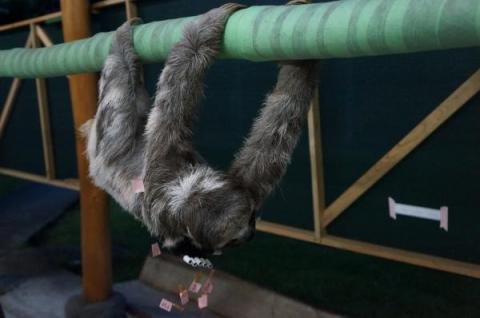Biology Professor's Sloth Research Published in the Journal of Experimental Biology

Dr. Michael Butcher is a Professor of Biology at YSU. Originally from Newport News, Virginia, he received his bachelor’s, master’s, Ph.D, and postdoctoral fellowship, degree in Zoology from Christopher Newport University, Wake Forest University, University of Calgary via Florida State University, and Clemson University respectively. Dr. Butcher joined theYSU faculty in 2008.
During his time at YSU, Dr. Butcher has managed to develop specialty courses in his area of expertise; established a productive research laboratory; mentored and trained 3-4 graduate students each year; and routinely published the findings of his scholarly research activity. Dr. Butcher teaches Introduction to Anatomy and Physiology (BIOL 1551), Mammalogy (BIOL 3725), Introduction to Human Gross Anatomy (BIOL 3705), Comparative Biomechanics (BIOL 4811/6911 + lab), and Research Methods for Thesis/non-Thesis (BIOL 6991-6994).
Dr. Butcher recently had his research published in the Journal of Experimental Biology. His research evaluates muscle activation patterns in forelimbs of three-toed sloths. He wants to understand that sloths demonstrate modulations in their neuromuscular patterns of muscle activation and recruitment that allows them to conserve energy during suspensory hanging versus when more force is needed during locomotion. Sloths may have the slowest contracting muscle fibers of all vertebrates for which similar data are available.
Dr. Butcher and other researchers sedated sloths and implanted microelectrodes in their forelimb muscles. After recovery from sedation, they had them perform trials of hanging and walking beneath a bamboo beam, as well as vertical climbing the fences of their large animal enclosure, all while wirelessly recording signals of muscle contraction. The electromyography (EMG) signals were analyzed for duration, intensity, and electrical impulse frequency during contraction. Finally, the results were compared across the three behaviors for differences in muscle activation properties.
The research indicated that sloths have modified their neuromuscular system to be tuned to recruit slow vs. fast muscle fibers (or motor units) to match postural vs. locomotor behaviors and this allows them to conserve metabolic energy all while providing an appropriate amount of strength for each behavior. In addition, sloths may have the slowest contracting muscle fibers that have ever been studied in vertebrates. Slow-contracting fibers maximize force while minimizing energy consumption.
In addition to his sloth research, Dr. Butcher has been involved with the YSU chapter of the American Medical Student Association (AMSA-YSU) for nearly 10 years as the faculty mentor. He is a regular Faculty Mentor for the prestigious Choose Ohio First scholarship program (5 years). He is also the Graduate Coordinator for the Biological Sciences Division of the Department of Chemical and Biological Sciences. Graduate student training has been and will continue to be one of his major commitments at YSU. If you students want to find out more information about Dr. Butcher’s research, click here.
Students who wish to contact Dr. Butcher, can email him at mtbutcher@ysu.edu or if you want talk to him in person, visit his office at x2195; 4013 in WBSH via his office hours T/TH 2:30-4pm, MW 4-5pm, or by appt.